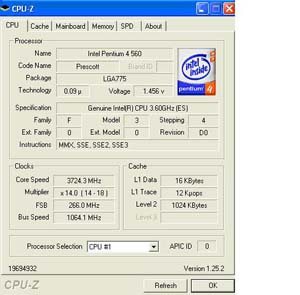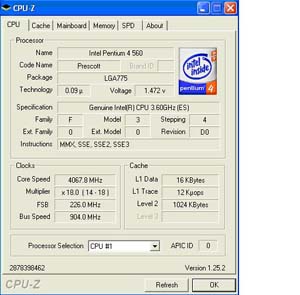The DFI 875P-T — LGA 775 meets Intel’s 875 chipset
Overclocking
Overclocking the 875P-T was an incredibly simple process. DFI’s EASY OVERCLOCK feature is a very simple and easy to understand program that should satisfy any beginning overclocker. Simply choose an overclock percentage between 2.5 and 15%, and let it rip! A word of caution though, be very careful mixing this feature with the memory features in the Advanced Chipset section. Overtightening the memory while maxing out the CPU can easily cause instability or worse….an unbootable system. For the more advanced user there are numerous tweaking options available with which you can maximize the O/C of your system.

First I dropped the multiplier on my processor to 14X (2.8GHz), changed the memory timing to “BY SPEED,” and started cranking up the FSB until I could no longer get my system to boot. At 270 on the FSB, my board started squealing and the system became very unstable, rebooting and finally refusing to enter Windows. Regardless of where I cranked the voltage to, and I tried everything up to and including 1.60v, I couldn’t get Windows to run. The best I could possibly do at a multiplier of 14 was 265 on the FSB — not too shabby, but nothing spectacular.

I increased the multi to 15 and was still running stable at 260 on the FSB. Cranking the CPU multiplier up to 18 (3.6GHz), my max O/C turned out at about 226 on the Front Side bus, still good enough for 4.07GHz! Not too shabby at all.

Looking at it objectively, this is a fairly good overclock on any system with stock Intel cooling, however looking at the end result and how everything up to 4GHz was stable, yet anything over 4GHz wasn’t . . . I tend to believe that Windows was the issue more than the processor or board.
I would be very interested to see what this system could do with some phase change or high end water cooling, but to be honest, I think that these overclocking for reviews should be conducted on air. In my opinion a review should show you the least you can expect… I believe that all components have different limits, therefore my high end results will be different from others, but by showing you the least you should expect, you can get a realistic idea of what your system should be able to accomplish.

Comments are closed.